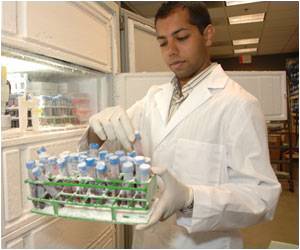A crucial step in DNA repair that could lead to targeted gene therapy for hereditary diseases such as children of the moon and a common form of colon cancer has been discovered by scientists.

The findings are published in this week's Proceedings of the National Academy of Sciences. The study was funded by the National Institute of Environmental Health Sciences.
Regents Professor Michael Smerdon and post-doctoral researcher Peng Mao found that when DNA is damaged, a specific protein must first be "unbuckled" to allow easy access for the DNA "repair crew." Without this unbuckling, entry to the damaged site is hampered by the compact arrangement of genes and protein in chromosomes called chromatin.
Smerdon and Mao's finding is one of the first to document details of how this repair process takes place in chromatin.
Daily demands for DNA repair
Each human cell sustains a range of assaults that can create up to 100,000 DNA injuries every day, said Smerdon. The cells must repair this damage by continually—and quickly—producing replacement DNA and proteins.
Advertisement
But when DNA is damaged by UV radiation or harmful substances, it forms an impenetrable mass that stalls the RNA polymerase, said Smerdon. Like a boulder on the railroad tracks, the lifeless lump blocks all protein production from that gene. Unless quickly repaired, the cell could die.
Advertisement
Children of the moon
Smerdon's laboratory studies repair deficiency diseases like xeroderma pigmentosum or XP, first identified as a possible hereditary disorder in 1874. Known as children of the moon, XP patients lack the enzymes to cut out damaged DNA and are so sensitive to UV light that even fluorescent lights can blister their skin.
Their skin cancer rates are 2,000 times higher than in people without the disorder. They can safely venture outside only at night.
Smerdon and his colleagues also study Cockayne Syndrome, a TCR deficiency disease that causes extreme sun sensitivity, nervous system degeneration and premature aging.
Other DNA repair deficits can cause a range of diseases such as leukemia, breast cancer and hereditary non-polyposis colorectal cancer, a common cause of colon cancer in Western nations.
Loosening the belt
Using yeast and human cells, Smerdon, Mao and their team discovered that there are two steps to the normal TCR repair process and that a protein in the chromatin, called H2B, is critically involved in the first step.
To help the repair enzymes gain entry to heavily shielded DNA, H2B first unbuckles a smaller protein. Like loosening your belt after a big dinner, this allows the strands of DNA to relax and move apart. As the strands open, the repair crew has room to come in and clear the damage.
This unbuckling of the smaller protein, ubiquitin, is saddled with a jawbreaker term called deubiquitylation, but Smerdon and Mao say it makes DNA repair more efficient and that without it repair would be next to impossible.
Source-Eurekalert












